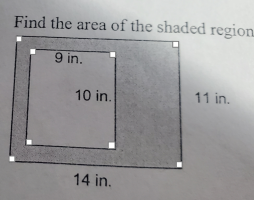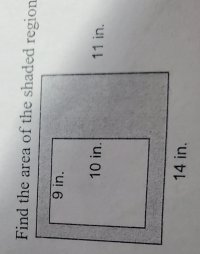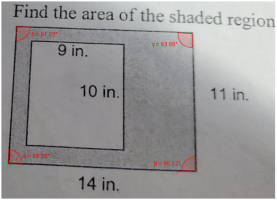You are using an out of date browser. It may not display this or other websites correctly.
You should upgrade or use an alternative browser.
You should upgrade or use an alternative browser.
Find the area of the shaded region
- Thread starter eddy2017
- Start date
eddy2017
Elite Member
- Joined
- Oct 27, 2017
- Messages
- 2,525
my work
[math]I found the area of the non-shaded region first[/math][math]A=l*w[/math][math]A=9in*10in[/math][math]A=90in^2[/math]
[math]shaded region[/math][math]A=l*w[/math][math]A=11in*14in[/math][math]A=154in^2[/math]
now, to find the area of the shaded region, I subtract the area of the non shaded area from it
[math]154in^2-90in^2[/math][math]Area of shaded region 64 in^2[/math]
Is this correct?
thanks
[math]I found the area of the non-shaded region first[/math][math]A=l*w[/math][math]A=9in*10in[/math][math]A=90in^2[/math]
[math]shaded region[/math][math]A=l*w[/math][math]A=11in*14in[/math][math]A=154in^2[/math]
now, to find the area of the shaded region, I subtract the area of the non shaded area from it
[math]154in^2-90in^2[/math][math]Area of shaded region 64 in^2[/math]
Is this correct?
thanks
D
Deleted member 4993
Guest
Your work would be some what correct - if those regions were rectangles. Nowhere in the image I could find that statement (assertion).my work
[math]I found the area of the non-shaded region first[/math][math]A=l*w[/math][math]A=9in*10in[/math][math]A=90in^2[/math]
[math]shaded region[/math][math]A=l*w[/math][math]A=11in*14in[/math][math]A=154in^2[/math]
now, to find the area of the shaded region, I subtract the area of the non shaded area from it
[math]154in^2-90in^2[/math][math]Area of shaded region 64 in^2[/math]
Is this correct?
thanks
and the second group of calculation starts with the following statement:
[math]shaded region[/math] ................... really - I don't think so. Later you said
[math]Area of shaded region 64 in^2[/math] ............... this is however is correct. You need to read/write carefully and review your statements.
eddy2017
Elite Member
- Joined
- Oct 27, 2017
- Messages
- 2,525
I'm confused here. Isn't the shaded region that of the whole rectangle except for the area that occupies the white area (non-shaded)?Yes, correct method and answer.
(A little note - you have used 'shaded region' in referring to the large rectangle and in referring to the actual shaded region).
eddy2017
Elite Member
- Joined
- Oct 27, 2017
- Messages
- 2,525
but these are rectangles, aren't they?. they are not squares!Your work would be some what correct - if those regions were rectangles. Nowhere in the image I could find that statement (assertion).
A rectangle is a 2D shape that has 4 sides, 4 corners, and 4 right angles. Opposite sides of a rectangle shape are the same length, with one pair being longer than the other pair. If all the sides of a rectangle were the same size, it would be known as a square. From those two words, we get "rectangle".
Can't we assume they are rectangles, then?
eddy2017
Elite Member
- Joined
- Oct 27, 2017
- Messages
- 2,525
maybe I should have set it up this wayYes, correct method and answer.
(A little note - you have used 'shaded region' in referring to the large rectangle and in referring to the actual s
Area of non-shaded region = 90in^2
then do the subtraction
and then state,
the area of the region that is shaded is 64 in^2 after subtracting the one that was not shaded.
D
Deleted member 4993
Guest
Where was it stated that those were right angles?and 4 right angles.
eddy2017
Elite Member
- Joined
- Oct 27, 2017
- Messages
- 2,525
So, what are they?. If not rectangles, or squares, what are they?.Where was it stated that those were right angles?
D
Deleted member 4993
Guest
Quadrilateral figures.So, what are they?. If not rectangles, or squares, what are they?.
eddy2017
Elite Member
- Joined
- Oct 27, 2017
- Messages
- 2,525
Yes!. Great!. Thanks.Quadrilateral figures.
Dr.Peterson
Elite Member
- Joined
- Nov 12, 2017
- Messages
- 16,093
I see no right angles at all:but these are rectangles, aren't they?. they are not squares!
A rectangle is a 2D shape that has 4 sides, 4 corners, and 4 right angles. Opposite sides of a rectangle shape are the same length, with one pair being longer than the other pair. If all the sides of a rectangle were the same size, it would be known as a square. From those two words, we get "rectangle".
Can't we assume they are rectangles, then?
I imagine that in the book they look more like right angles than they do in your picture; and in such books you are often expected to make such assumptions knowing they wouldn't give you an impossible problem.
But a really good book would always tell you what to assume, and not make you guess based on what things look like! Math is not about assuming things without reason. That's a valid point!
Yes, correct method and answer.
(A little note - you have used 'shaded region' in referring to the large rectangle and in referring to the actual shaded region).
Yes, assuming they are rectangles, your solution is correct, with the note I made earlier.I'm confused here. Isn't the shaded region that of the whole rectangle except for the area that occupies the white area (non-shaded)?
(They only gave the length and breadth of each shape, so I assume they meant these to be rectangles, and it was probably a reasonable assumption for you to make in solving it - you know the context, you know better than me then).
They should give all the information needed to solve the question, so they might either have stated they are rectangles or marked in right angles.

The danger in making assumptions is that sometimes they may be unwarranted!
D
Deleted member 4993
Guest
My point is:
If particular ASSUMPTION/S are needed - those should be explicitly stated.
If particular ASSUMPTION/S are needed - those should be explicitly stated.
eddy2017
Elite Member
- Joined
- Oct 27, 2017
- Messages
- 2,525
I totally agree and it is like you say. They expect us to assume it and that is not correct.I see no right angles at all:
I imagine that in the book they look more like right angles than they do in your picture; and in such books you are often expected to make such assumptions knowing they wouldn't give you an impossible problem.
But a really good book would always tell you what to assume, and not make you guess based on what things look like! Math is not about assuming things without reason. That's a valid point!


